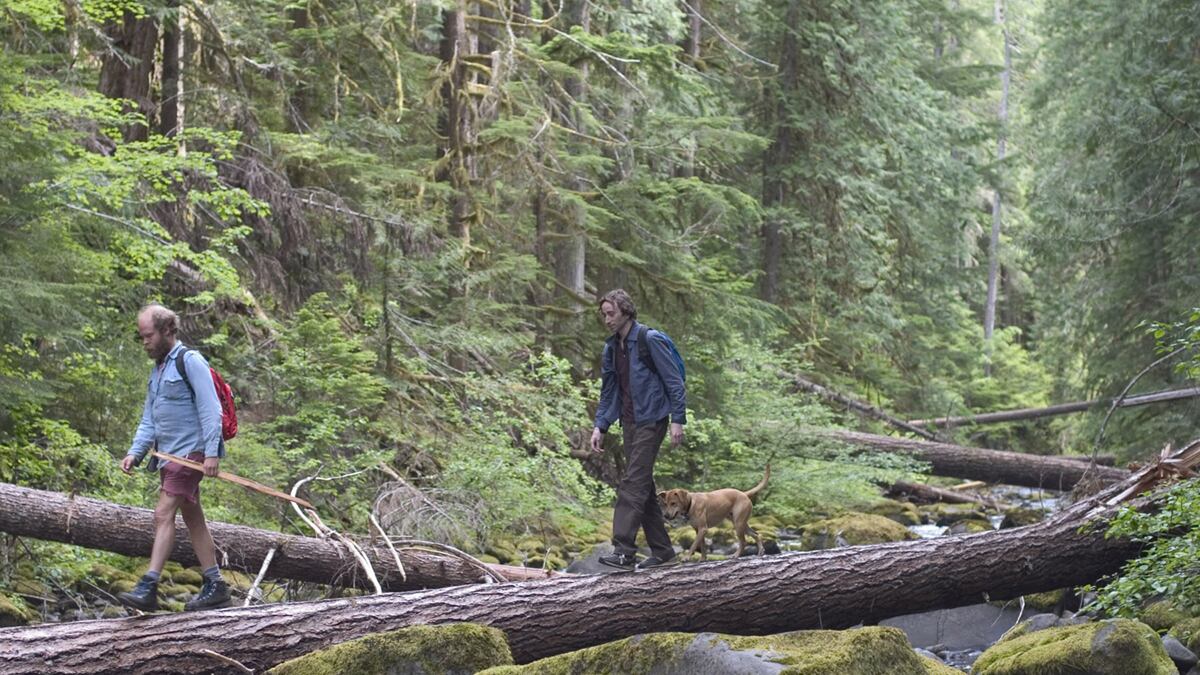Fifteen-year film anniversaries aren't particularly marquee moments. They lack 25's nostalgia or the prestige of 50. But they're useful: 15 years on, you can make out the vapors of a time just disappeared. As Kurt from Old Joy would say, you can finally see "everything you just went through…you see that it has a shape after all."
The release of Old Joy in 2006, Kelly Reichardt's first Oregon feature, announced the director as one of the state's (and country's) great 21st century artists who would go on to make a series of films in our state, including Wendy and Lucy (2008) and Meek's Cutoff (2010). A Sundance breakout 15 years ago, Old Joy sketches the uneasy friendship between two Portlanders—Kurt (Will Oldham) and Mark (Daniel London)—seeking out Bagby Hot Springs for a hike, a soak and a hundred little talks. As Roger Ebert said in his 2006 rave, assessing Old Joy by its plot is like saying "James Joyce's The Dead is about some Irish people who go to a party and then go home."
Showcasing Reichardt's trademark attention to detail and short story author Jon Raymond's trademark intimacy, Old Joy remains a stirring but ambiguous journey, punching miles above the weight class as a film shot by eight people in under two weeks. Its slight, 70-minute frame belies how deeply Reichardt peers into Mark and Kurt's stagnated bond and divergent lives, as they camp, guzzle Hamm's and talk physics.
Mark is settling down in a Portland about to rapidly transform. He tries and fails to meditate in his yard before tuning into Air America. His pregnant wife, Tanya, blends a green smoothie. His character seems exemplified by his child-rearing philosophy: "I guess we'll do whatever it is people do."
Kurt clings to freedom by clinging to nothing. He's traveled nomadically from Ashland to Big Sur to Arizona. He's crashing in a dandelion-colored house on Northeast 12th Avenue, in the shadow of the Portland Bottling Company's bygone 7UP monument. His character seems exemplified by his self-rearing philosophy: "I never got myself into anything I couldn't get myself out of."
If Old Joy projects eternal discovery, perhaps it's because Reichardt hadn't yet lived in Oregon when she made the movie. It captures the unpredictability of giving oneself over to the Pacific Northwest wilderness, which is just as likely to result in a precious experience as an upsettingly weird one. Either way, every time feels a bit like the first.
But finality looms too. "End of an era!" Kurt proclaims of Portland's dying small businesses and rising housing costs, all set to Yo La Tengo's horizonwide Western score. The losses kept coming. Reichardt told WW last year that many of the Clackamas County forests where she shot Old Joy have since been clear cut.
Still, the film is not in itself an elegy, especially for so-called Old Portland. The mutable, minimalist achievement suggests we wade every day through unprocessed life changes. These suspended moments of transformation are Reichardt and Raymond's specialties. Their collaborations drop in on lost Oregon wagon trains (Meek's Cutoff), or an unhoused Alaska-bound woman stranded in Portland (Wendy and Lucy), or frontier entrepreneurs whose business practices can't possibly sustain them (First Cow). When the credits roll, the audience can sense that fate will spit these characters out into new forms. But we never see that part, just as we seldom observe real-time changes in ourselves.
Watching Old Joy this winter, there's an almost coercive temptation to read the film through a pandemic lens, dearly missing friends and spontaneous connection. But that's a slight misapprehension. World-altering events, the kind Mark soaks in via talk radio, don't slice the invisible fissures between longtime friends; we do that ourselves.
But if sorrow is nothing but "worn-out joy," as Kurt explains the film's title, it's hard not to take in Old Joy without feeling the weight of our prolonged, collective wearing out. So much joy has aged before our eyes. Your phone wants to show you unreachable memories from one year ago today. Friends and family hope you can rebook last year's scheduled happiness for summer or fall. And if you lost someone last year, maybe you carry around all their old joy lodged in your chest.
Love should do more than just weather into sorrow. Let it change shape. This era will end too.
SEE IT: Old Joy is available to stream or purchase on DVD or Blu-ray via the Criterion Collection website, criterion.com.
